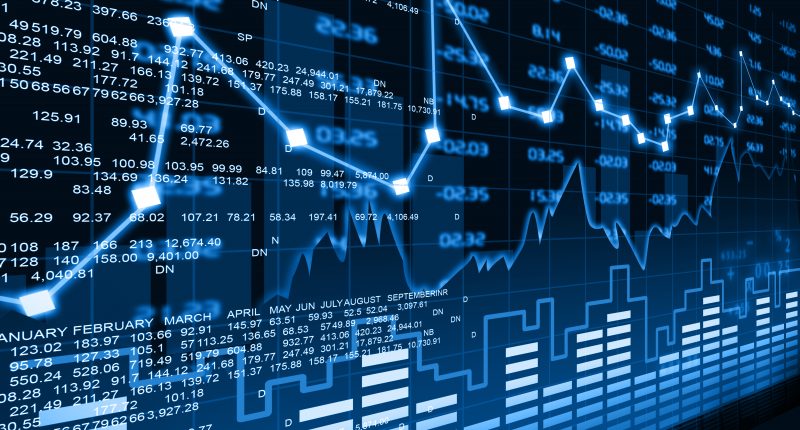Australian shares are pointing lower after robust US business data triggered heavy falls on Wall Street as traders bet on significantly higher interest rates to contain inflation.
The S&P 500 tumbled 2 per cent to its heaviest loss since mid-December. The rate-sensitive Nasdaq lost 2.5 per cent and the Dow more than 2 per cent.
The Australian dollar skidded 0.8 per cent. Oil and gold also declined. Iron ore and copper were supported by hopes of a pick-up in Chinese demand.
The S&P/ASX 200 looks set for a fresh five-week opening low, according to futures action. The SPI 200 declined 45 points or 0.62 per cent in night-time trade.
Rio Tinto, Woolworths and Santos release earnings today. Quarterly wage price data is also due.
Wall Street
US stocks slumped as a rebound in business activity sharpened fears that the top of the current interest rate cycle is still some way off. Bond yields climbed to their highest since November.
The S&P 500 dived 82 points or 2 per cent. The Dow Jones Industrial Average lost 697 points or 2.06 per cent, its worst performance since December 15. The Nasdaq Composite gave up 295 points or 2.5 per cent.
Private-sector business activity surged to an eight-month high this month, according to S&P Global. The agency’s flash US Composite Output Index rose to 50.2 from a January reading of 46.8.
The index measures activity in the manufacturing and services sectors. Readings above 50 indicate expanding activity. The index traded below 50 for the previous seven months.
The report is the latest in a series of signals that rate hikes have yet to seriously slow the US economy. Reports this month on retail sales, jobs and factory output suggest the Federal Reserve has more work to do to bring down inflation. Headline inflation remains above 6 per cent 11 months after the Fed’s first increase.
Market pricing now suggests a 3.8 per cent chance benchmark rates go as high as 5.75-6 per cent by July. The current federal funds rate target is 4.5-4.75 per cent. Just a few weeks ago, the market anticipated a peak rate of 5 per cent.
“This data doesn’t do anything to get rid of the fears that the Fed might be more hawkish and might feel like taking rates higher than what investors were thinking just a month ago,” Brian Jacobsen, senior investment strategist at Allspring Global Investments, told Reuters.
Benchmark ten-year US treasury yields climbed to 3.95 per cent, the highest level since November. The two-year yield reached 4.7 per cent after trading as low as 4.04 per cent earlier this month.
Rising yields weighed on growth stocks whose valuations depend most on future earnings that get marked down as rates increase. Tesla, Nvidia, Netflix, Apple and Amazon all lost at least 2.6 per cent.
Australian outlook
A bearish session in the US points to further erosion of the ASX’s strong start to the year. The balloon is slowly losing altitude as air seeps out of the January rally.
If the futures outlook proves accurate, by today’s close the S&P/ASX 200 will have given back roughly half of its January gains. The Australian benchmark has been losing height since the end of the first week of February. The index fell 0.21 per cent yesterday after BHP’s earnings fell short of expectations.
Rio Tinto, Woolworths and Santos head up a long list of companies reporting earnings today. Also on the list: Domino’s Pizza, WiseTech, Flight Centre, OZ Minerals, Scentre Group, Coronado, Reece, Worley, AUB Group, Qualitas, Wagners, Siteminder, Lovisa, Spark New Zealand, Emeco, EML Payments, Karoon Energy and Rural Funds Group.
Growth and rate-sensitive property stocks led the selling in the US. The three sectors dominated by Big Tech lost between 2.29 and 3.34 per cent.
Real estate gave up 1.97 per cent. Industrials and financials were also notably weak, falling 2.29 and 2.01 per cent, respectively. Energy was the best of a bad bunch with a loss of 0.3 per cent.
The Australian dollar was once again collateral damage to shifting expectations for US rates. The Aussie was knocked down 0.81 per cent to 68.53 US cents.
The outlook for domestic interest rates should be clearer this morning following quarterly wage price data at 11.30 am AEDT. The Wage Price Index is a leading indicator for inflation – the more businesses pay employees, the more costs they pass on to consumers.
Economists expect wage growth of around 1 per cent for the three months to the end of last year. Surprises either side of that number are likely to trigger either buying or selling. A separate report on construction work is due at the same time.
Technology One holds its annual general meeting today in Brisbane.
Commonwealth Bank, AGL, Domain Holdings and SG Fleet trade ex-dividend.
Commodities
Iron ore rallied above US$130 a tonne after BHP said it saw evidence of “green shoots” in the Chinese economy. CEO Mike Henry said Chinese and Indian growth would help offset any weakness in western economies over the next 12 months. He cited Chinese data on new loans, house prices and business sentiment.
“As we progress into the second half, and then the year ahead, we’re seeing momentum build in China,” Henry told CNBC.
The most-traded May ore on China’s Dalian Commodity Exchange rallied 3.4 per cent in daytime trade to 919 yuan (US$133.80) a tonne.
Copper overcame early pressure to reach a three-week high. Benchmark copper on the London Metal Exchange climbed 0.42 per cent to US$9,179.50 a tonne.
Aluminium edged up 0.06 per cent. Tin gained 3.01 per cent. Nickel eased 0.78 per cent, lead 0.37 per cent and zinc 1.07 per cent.
BHP’s US-traded depositary receipts finished just 0.26 per cent lower despite a sharp 3.64 per cent decline in UK trade. Rio Tinto firmed 1.25 per cent in the US after losing 1.16 per cent in the UK.
A “risk-off” session saw oil reverse almost all of Monday’s US$1.08 rally. Brent crude settled US$1.02 or 1.2 per cent weaker at US$83.05 a barrel.
Oil shed 4 per cent last week amid speculation the strength of the US economy would encourage the Fed to raise benchmark rates so high that a recession becomes inevitable.
“From a demand standpoint, recessions are clearly not a positive situation for consumption of refined products,” analysts at Sevens Report Research wrote.
Gold retreated as the US dollar and treasury yields rose. Higher yields increase the opportunity cost of holding metals, which do not pay a coupon.
Gold for April delivery settled US$7.70 or 0.4 per cent lower at US$1,842.50 an ounce. The NYSE Arca Gold Bugs Index shed 1.22 per cent.
Battery metal miners fell to a four-week low. The Global X Lithium & Battery Tech ETF declined 2.85 per cent on the New York Stock Exchange.








